Lamb’s Ear (Stachys byzantina) is a versatile, well-liked perennial that makes a wonderful garden companion. It is compatible with many plants, including shrubs, flowers, herbs, and decorative grasses. Lamb’s ear’s smooth, silvery-gray leaves contrast beautifully with other plants, boosting the overall visual appeal of the garden.
Lamb’s ear has distinct qualities as a plant. Its velvety, lamb-ear-shaped leaves are attractive and act as natural mulch, storing moisture and limiting weed development around surrounding plants. Because of this, Lamb’s Ear is an excellent ground cover, preserving the soil and fostering a healthier habitat for the plants it grows with.
Lamb’s ear has therapeutic properties in addition to its aesthetic appeal. Its leaves are antibacterial and traditionally used as wound dressings because of their delicate texture and healing abilities. The plant is also known for its drought tolerance, making it a reliable friend during dry seasons.
However, Lamb’s Ear, like other plants, suffers its own set of obstacles. If cultivated in poor-draining soils, it is subject to root rot, and overwatering can lead to decreased vigor. Pruning spent flower stems and preserving adequate ventilation can aid in disease prevention.
Gardeners may create harmonious landscapes that thrill the eye and boost each plant’s development and resilience by deliberately including Lamb’s Ear in companion planting. Lamb’s ear is a helpful ally in the search for a flourishing and sustainable outdoor refuge since it is a long-lasting and lovely addition to any garden.
In this article, we are looking into Twenty-Eight (28) Good companion plants and Five (5) Bad Companion plants for Lamb Ear; we will also delve into their advantages and disadvantages to Lamb Ear.
Table of Contents
GOOD COMPANION PLANTS FOR LAMB’S EAR
Herbs
1. Oregano (Origanum vulgare)
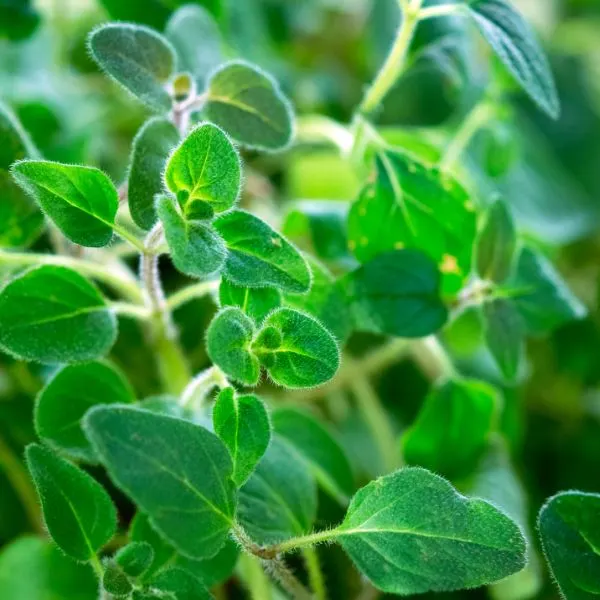
Oregano and Lamb’s Ear connect harmoniously in nature’s garden dance. Oregano provides its kind neighbor with scented leaves and exquisite purple blossoms, deterring pests that may disturb the peaceful temperament of Lamb’s Ear and acting as a culinary powerhouse.
In return, Lamb’s Ear offers a protective covering of silvery-soft leaves that shields the ground and retains critical moisture. Oregano’s short roots embrace the cold sanctuary provided by Lamb’s Ear, creating a peaceful microclimate where life thrives without the need for tilling or excavating.
As the seasons pass, their connection strengthens, and they feed the soil with organic materials, supporting each other for years to come. Together, Oregano and Lamb’s Ear create a sustainable and abundant canvas of natural beauty through companion planting.
2. Thyme (Thymus spp.)
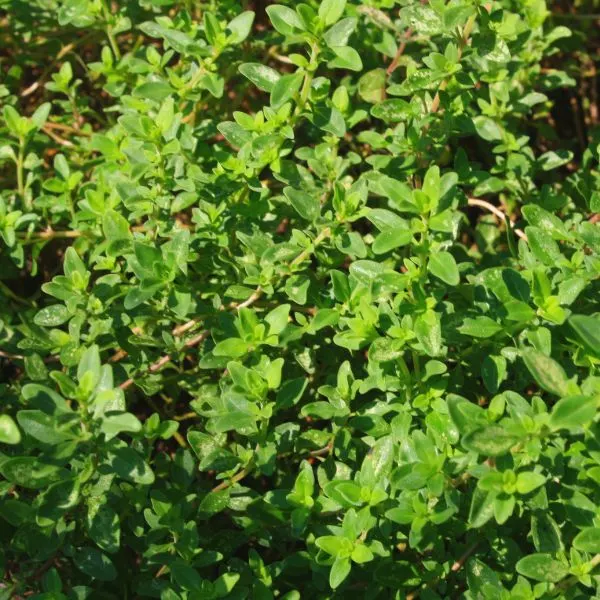
Thyme and Lamb’s Ear intertwine in harmonic oneness within the companionable garden, forming a symbiotic link supporting bountiful growth and protection. Thyme’s profusion of exquisite blossoms entices pollinators to dance amidst its thick leaves, assisting Lamb’s Ear in its reproductive efforts. Additionally, Thyme’s antibacterial capabilities protect the delicate leaves of Lamb’s Ear, preserving its brilliant appearance.
In return, Lamb’s Ear acts as a living mulch, enveloping the earth with its velvety leaves and retaining moisture in the soil, providing Thyme with a steady water supply during drought times. Furthermore, Lamb’s Ear offers shade to protect Thyme’s roots from the hot sun, creating a tranquil refuge for the herb to bloom in scented grandeur.
The enchanting story of mutual prosperity unfolds as each couple finds peace and strength in the other’s presence, permanently connected in the marvelous dance of nature’s harmony.
Flowers
3. Lavender (Lavandula spp.)

Lavender gracefully dances with the tenacious Lamb’s Ear in the enchanted realm of companion planting, forming an elegant partnership. Lavender envelops Lamb’s Ear with a peaceful atmosphere, attracting beneficial insects and pollinators. This aromatic embrace acts as a natural screen, protecting Lamb’s Ear from pests and allowing undisturbed delicate leaves to develop.
Lamb’s Ear provides steadfast support as a living mulch beneath Lavender’s narrow stems. Its velvety leaves efficiently conserve moisture, offering Lavender the much-needed water-retentive environment it craves. Together, their roots interweave, and the ground blossoms in everlasting partnership, creating an oasis of peace where they enjoy each other’s beauty and strength.
4. Salvia (Salvia spp.)
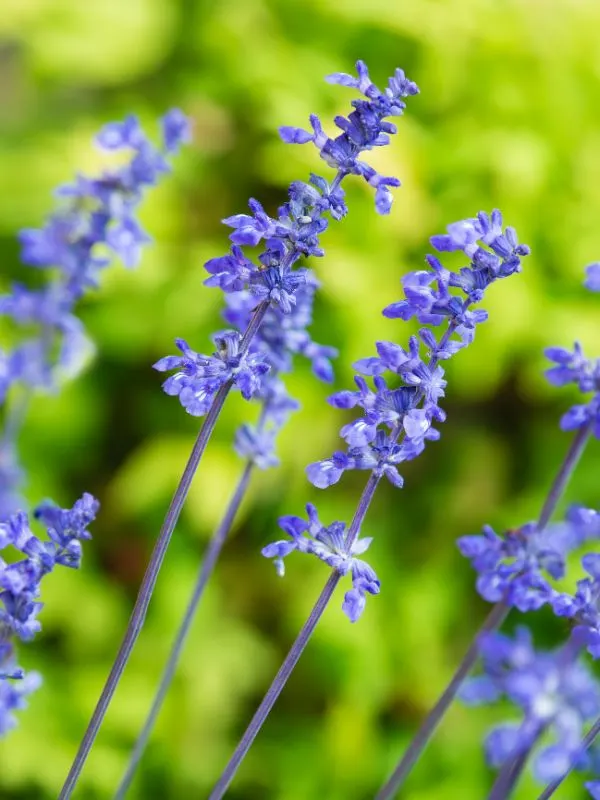
Salvia twirls beautifully beside Lamb’s Ear in a friendly garden dance, forming a happy alliance that nourishes both plants. Its bright flowers attract pollinators like bees and butterflies, ensuring Lamb’s Ear’s fuzzy leaves remain vigorous and alive. Salvia’s vertical growth provides shade and protection from searing rays, while Lamb’s Ear, with its low-lying habit, functions as a living mulch, saving soil moisture for both partners.
Salvia’s scented leaves act as a natural insect repellent, protecting Lamb’s Ear from invaders. Together, they exemplify the essence of cooperative gardening, a marriage of beauty and purpose that inspires a vibrant, plentiful garden.
5. Catmint (Nepeta spp.)
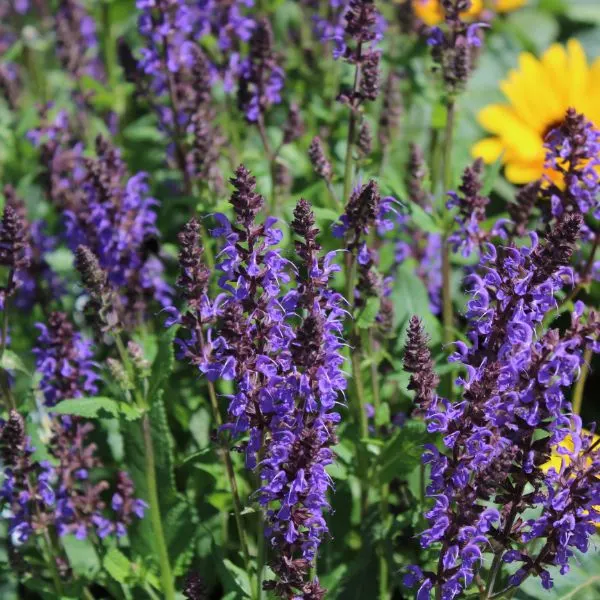
Catmint and Lamb’s Ear gently intertwine in the garden, creating a beautiful link that supports both plants with reciprocal advantages. Catmint entices pollinators with its stunning purple blossoms and scented foliage, allowing them to romp among Lamb’s Ear’s delicate, silvery leaves. Catmint’s allure draws bees and butterflies to the wide surfaces of Lamb’s Ear, where they gather nectar and pollen with glee.
As a herbal friend, Catmint kindly offers its resistance, repelling pests that would disrupt the peace of Lamb’s Ear. In return, the thick foliage of Lamb’s Ear works as living mulch, protecting Catmint’s roots from the searing heat and offering a cool, warm haven. These kindred spirits dance through the seasons in a timeless cadence, expressing the essence of companion planting – a symphony of collaboration and natural elegance in the garden.
6. Yarrow (Achillea millefolium)
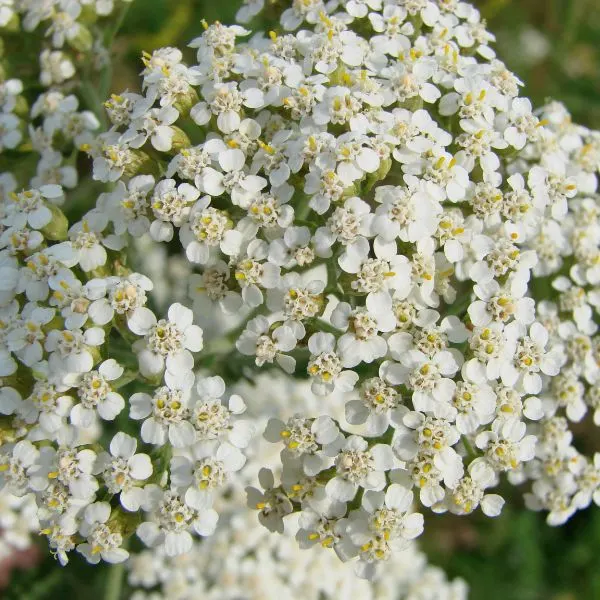
Yarrow (Achillea millefolium) dances beautifully with Lamb’s Ear in the domain of companion planting, their union a symphony of mutual support. With its delicate, fern-like leaves, the yarrow provides numerous advantages to its surrounding companion. It acts as a natural pest repellent, keeping unwelcome invaders at bay and allowing Lamb’s Ear to thrive. Furthermore, yarrow’s deep roots work ceaselessly to enhance soil structure, increasing moisture retention and feeding the soil, which Lamb’s Ear gratefully absorbs.
In exchange, Lamb’s Ear gives its low-growing, velvety leaves to form a living mulch, protecting yarrow’s roots from intense sunlight and providing a cooling hug. Their interwoven growth patterns create a gorgeous tapestry, ensuring a happy and prosperous partnership, a tribute to nature’s interconnectedness.
7. Purple Coneflower (Echinacea purpurea)
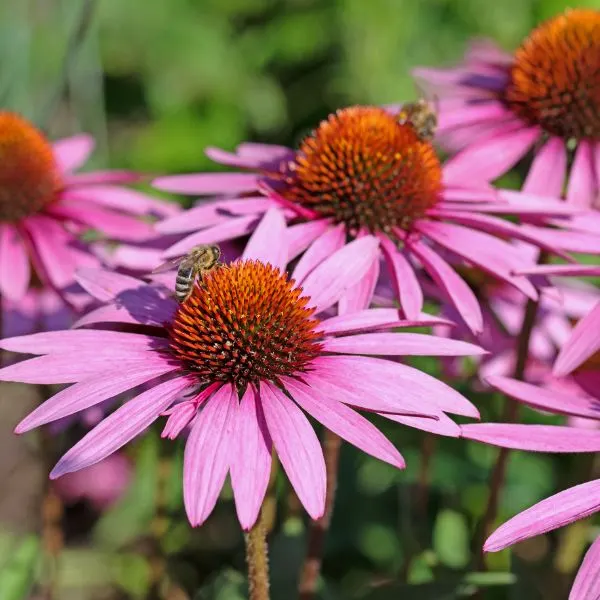
Echinacea and Lamb’s Ear gently whirl together in a harmonious garden dance, creating an exquisite tapestry of camaraderie. With its brilliant blooms and healing aura, Echinacea attracts a symphony of pollinators, serenading Lamb’s Ear and improving its ability to attract beneficial insects that keep the garden in balance. As the sun’s warmth promotes their relationship, Lamb’s Ear reciprocates by forming a protective canopy that shields Echinacea’s roots from the searing rays.
The collaboration goes beyond appearance; Echinacea’s deep taproots work ceaselessly to enrich the soil, while Lamb’s Ear’s thick foliage keeps unwanted weeds at bay. Echinacea finds a devoted friend in this dazzling link, while Lamb’s Ear finds an ally in health and vigor, sowing the seeds of a healthy and radiant garden.
8. Coreopsis (Coreopsis spp.)
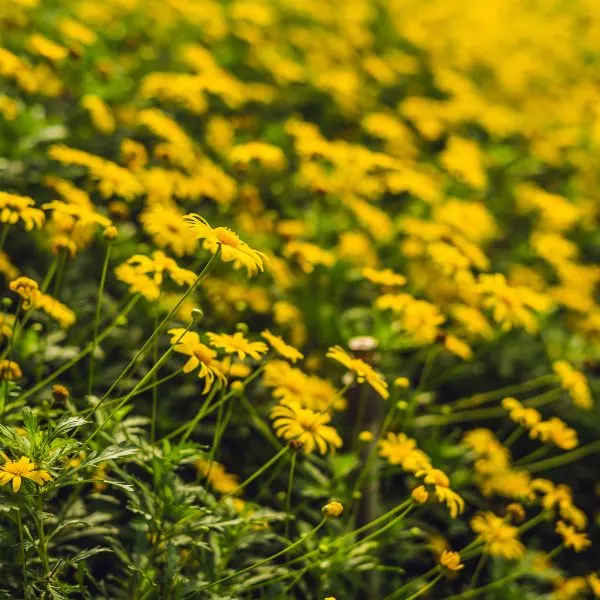
Coreopsis is a delightful addition to the garden, gently interweaving with Lamb’s Ear in a beautiful dance of companion planting. Its brilliant daisy-like blossoms attract a plethora of important pollinators, ensuring that Lamb’s Ear is frequently visited. In return, Lamb’s Ear, with its velvety, silvery leaves, functions as a living mulch, generously sheltering the soil and saving valuable moisture for the nearby Coreopsis on hot days. Furthermore, the thick foliage of Lamb’s Ear acts as a natural weed control, keeping unwelcome intruders at bay.
Together, they provide a balanced ecology where Coreopsis’ dazzling colors light up the surroundings, and Lamb’s Ear offers a soothing backdrop. Flourishing in this happy partnership, they exemplify the profound beauty of mutual support and harmony in the garden.
9. Black-eyed Susan (Rudbeckia spp.)
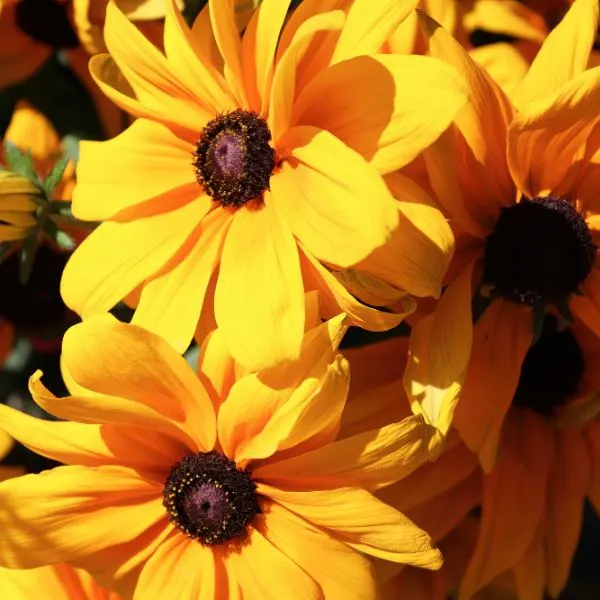
Black-eyed Susan twirls in perfect unison with the tiny Lamb’s Ear in a joyous garden dance. These two friends share a bond that enhances their beauty together. Black-eyed Susan’s golden-yellow petals catch the sun’s warm embrace, attracting pollinators to join her Lamb’s Ear companion, generously offering a soft, silvery retreat.
Their connection goes beyond aesthetics. Black-eyed Susan’s roots diligently enhance soil structure with their nitrogen-fixing abilities, benefiting herself and her nearby Lamb’s Ear companion. In return, Lamb’s Ear stands vigilant, providing shade and protection from the searing heat for her lively friend.
This friendship grows on mutual appreciation, with one plant amplifying the qualities of the other, creating a symphony of colors and vitality. Black-eyed Susan and Lamb’s Ear embody the essence of a successful garden pairing.
10. Bee Balm (Monarda spp.)
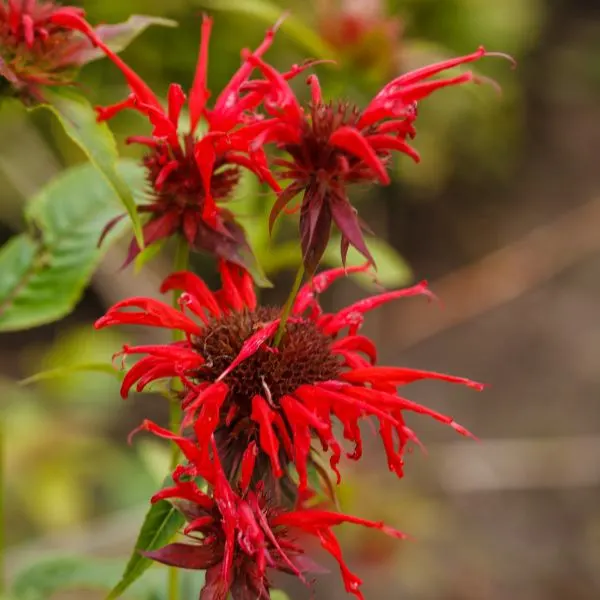
Bee Balm dances gracefully as the ideal companion for Lamb’s Ear in the lovely world of no-dig gardening. Bee Balm’s beautiful flowers, available in a variety of colors, draw a symphony of pollinators, adding to the garden’s already bustling vitality. This aromatic plant generously distributes its nectar, attracting helpful pollinators and butterflies and fostering a vibrant ecological balance that benefits Lamb’s Ear.
The beneficent dance continues as Lamb’s Ear returns the favor. Its velvety foliage provides a comfortable haven for Bee Balm, shielding its young roots from the sun’s beams. As the fragrant duo intertwines, they form a magical paradise where essential oils from both plants repel pests and protect each other from potential threats.
Bee Balm’s vibrant beauty and Lamb’s Ear’s soothing embrace reflect nature’s teamwork, demonstrating that when both plants work together, they flourish, blooming with unbridled delight and elegance.
11. Marigold (Tagetes spp.)
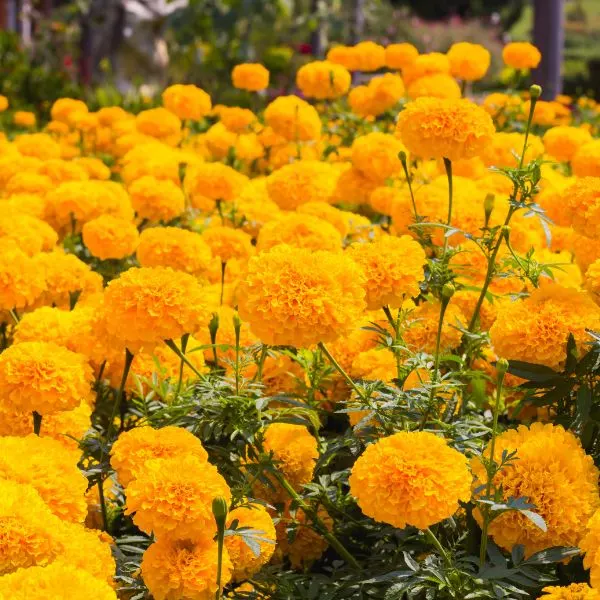
A wonderful dance exists in the fertile world of gardening between the cheerful personality of Marigolds and the soft Lamb’s Ear. These beautiful, golden blossoms exude positive energy, attracting helpful insects such as ladybugs and hoverflies and acting as alert sentinels against any pests that dare to approach our prized Lamb’s Ear. Marigolds repel nematodes and other dangerous creatures, providing their partner an essential layer of protection.
In exchange, Lamb’s Ear provides soft, silvery leaves that act as a living mulch, hugging the soil to conserve moisture and discourage weeds. This kind of act protects the Marigold from the rigors of competition, allowing it to thrive and shine with its golden radiance. Together, these two kindred spirits exhibit the beauty of garden harmony, encouraging each other’s development, health, and grandeur while contributing a kaleidoscope of hues and textures to nature’s tapestry.
12. Calendula (Calendula officinalis)
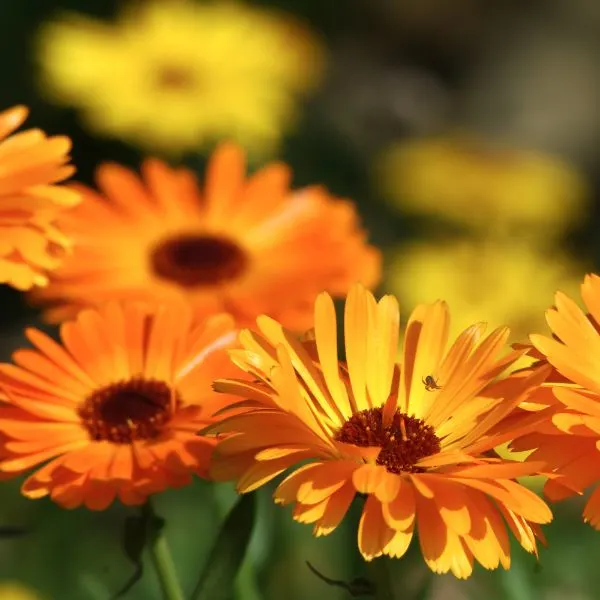
Calendula and Lamb’s Ear form a beautiful connection that nourishes each other’s development in the lovely dance of companion gardening. Calendula’s brilliant blossoms, like golden rays, attract pollinators, benefitting Lamb’s Ear by boosting cross-pollination and increasing seed production. Furthermore, the vibrant petals of Calendula act as a living mulch, protecting Lamb’s Ear from direct sunlight, controlling soil temperature, and storing valuable moisture. In exchange, the vulnerable Calendula seedlings are protected from severe winds and potential predators by the soft and velvety Lamb’s Ear leaves. The union of these two kind souls provides an aesthetically appealing show and promotes a healthy ecology where mutual support builds an enduring friendship.
13. Dianthus (Dianthus spp.)
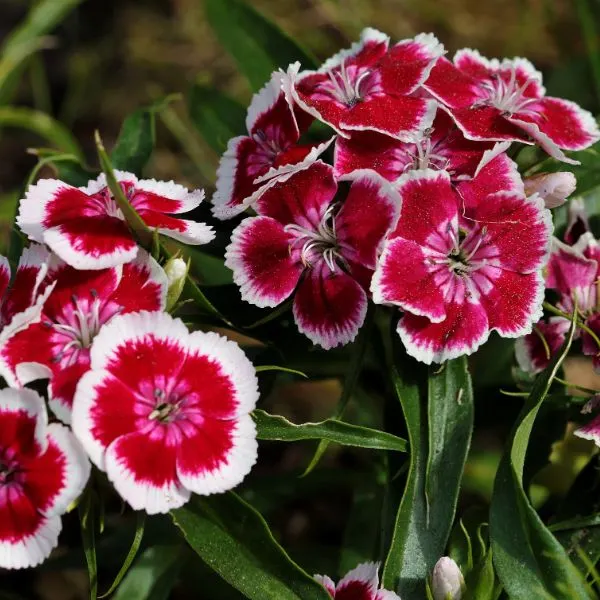
Dianthus meets a compatible partner in Lamb’s Ear in the fascinating dance of the garden, developing a wonderful companion relationship. Dianthus adds an air of refinement to the rustic beauty of Lamb’s Ear with its stunning blossoms and subtle smell.
Dianthus thrives when the sun’s warm embrace nurtures the earth, and its nectar-rich blossoms become an alluring beacon to pollinators. In response, Lamb’s Ear stands firm, providing a luxurious ground cover that protects the soil and preserves moisture and a shelter for beneficial insects that defend Dianthus from unwanted pests.
Their roots intertwine to form a tapestry of beauty and harmony, a tribute to nature’s ingenuity. When Dianthus and Lamb’s Ear are planted together, the landscape transforms into a symphony of color and texture, a monument to the beauty of companionship.
14. Penstemon (Penstemon spp.)
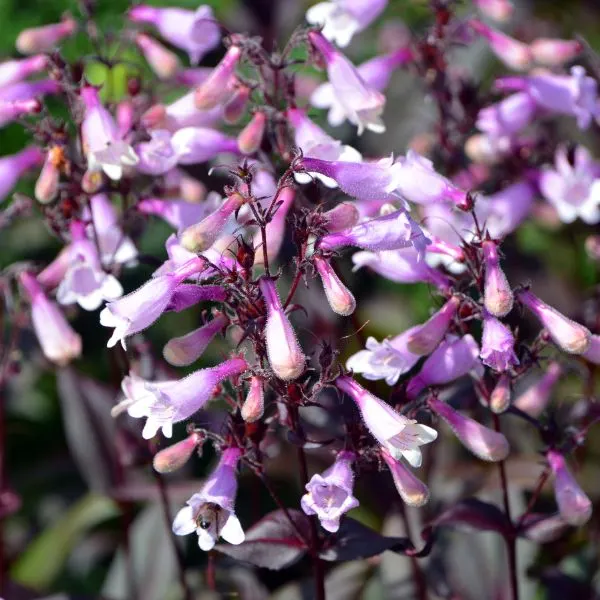
Penstemon and Lamb’s Ear have embraced a harmonious relationship in the lovely dance of the garden, where each bestows its particular gifts on the other. With its vivid flower beauty, the sturdy Penstemon draws pollinators like a magnet, guaranteeing Lamb’s Ear receives an abundance of visits to its soft, fuzzy leaves.
In exchange, the Lamb’s Ear acts as a kind neighbor, shielding Penstemon’s roots from the blazing sun with its low-lying leaves and offering shade and relief. Their roots intertwine in the rich soil, building a tapestry of cooperation, exchanging critical nutrients, and supporting a growth environment.
However, their friendship truly shines through their mutual support in the face of adversity. Penstemon’s sturdy stems protect the more fragile Lamb’s Ear from bending under the weight of rain. Penstemon and Lamb’s Ear make an inseparable duet in this symphony of friendship, boosting one another’s beauty and resilience in the evergreen embrace of nature’s wisdom.
15. Veronica (Veronica spp.)
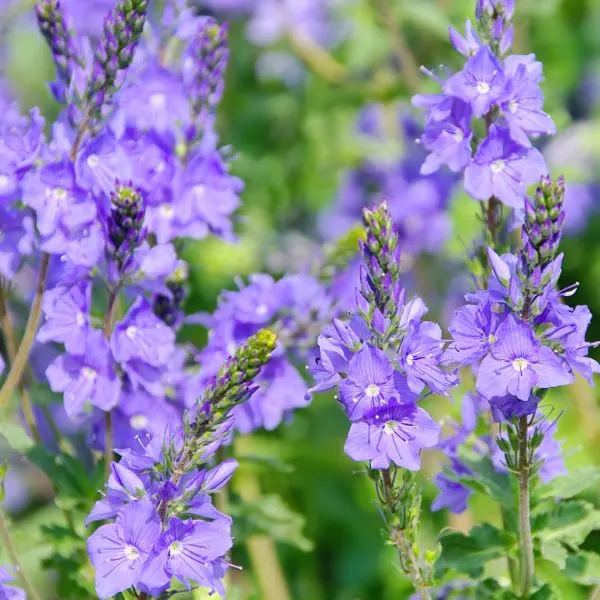
The presence of Veronica beside Lamb’s Ear bestows a harmonious partnership in the lovely dance of companion planting, where one plant favors the other with distinct gifts. Veronica’s tenacity and evergreen nature serve as a steady companion, providing a backdrop of rich foliage that complements Lamb’s Ear’s delicate, velvety leaves.
Veronica’s erect personality also serves as a protective sentinel, creating a gentle barrier from strong winds and excessive sun for the more fragile Lamb’s Ear. In exchange, Lamb’s Ear, with its low-growing, mat-forming habit, creates a green tapestry underneath Veronica’s vertical beauty, hiding the soil and limiting weed encroachment.
They work together to produce a healthy ecology, luring pollinators with the captivating appeal of Veronica’s delicate petals and the magnificent spikes of Lamb’s Ear flowers. Their collaboration graces the garden with a brilliant show and produces a caring atmosphere that promotes development and beauty to coexist.
16. Artemisia (Artemisia spp.)
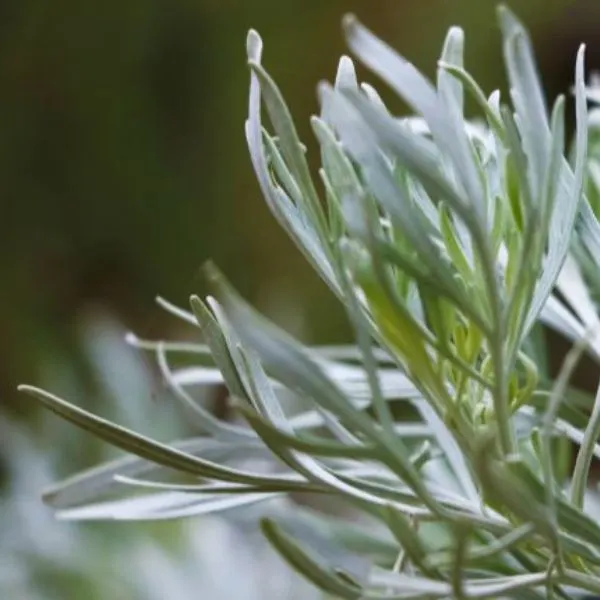
Artemisia delicately intertwines with Lamb’s Ear in the garden’s fanciful dance, generating a harmonic symphony of advantages for both plants. Artemisia’s feathery foliage acts as a delicate, scented blanket, giving shade and shelter for Lamb’s Ear’s soft, fuzzy leaves. This natural cover protects Lamb’s Ear from the sun’s rays and helps retain moisture, enabling its survival during hot times.
The pungent oils of Artemisia spread through the air, deterring pests that would otherwise bother Lamb’s Ear. Artemisia’s repelling characteristics operate as a barrier in this charming alliance, protecting its surrounding friend from potential damage.
In exchange, Lamb’s Ear, with its low-lying shape, functions as a living mulch for Artemisia, enveloping the soil with its dense mat, controlling weeds, and retaining valuable moisture. Artemisia and Lamb’s Ear produce a captivating duet, demonstrating the wonders of companion planting in the growing garden tapestry.
17. Liatris (Liatris spp.)
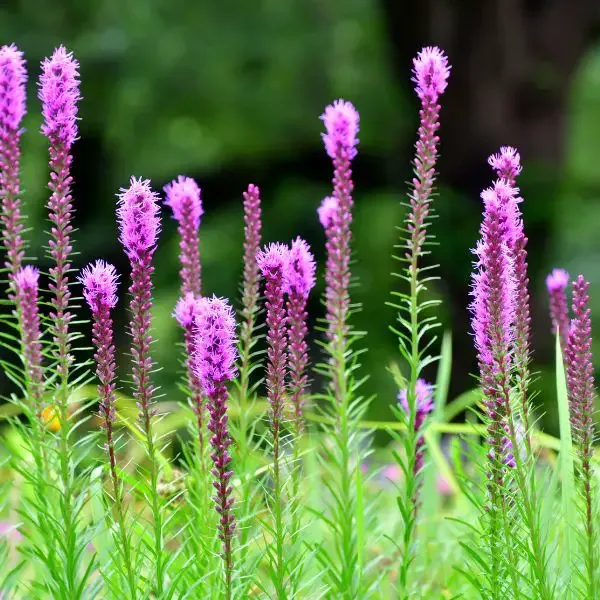
Liatris finds a harmonic mate in the steady embrace of Lamb’s Ear in the wonderful dance of companion planting. Liatris acts as a living beacon, enticing pollinators like butterflies and bees to join in a joyous feast with its beautiful vertical flowers of brilliant purples and pinks. These nectar-rich blooms attract these useful insects, resulting in a garden symphony of life.
In exchange, Lamb’s Ear gratefully gives its velvety leaves as a relaxing haven for visiting animals. The thick leaves of Lamb’s Ear act as a living mulch, creating a cooling cover for Liatris roots, protecting them from blazing sunshine and maintaining crucial moisture in the soil. Furthermore, the capacity of Lamb’s Ear to repel pests like aphids and spider mites acts as a sturdy defender, protecting the Liatris blossoms from potential injury.
Together, Liatris and Lamb’s Ear dance the waltz of mutual support, enhancing the garden with their graceful friendship and painting nature’s canvas with brilliant hues and textures, creating a masterpiece as a result of their flourishing union.
18. Euphorbia (Euphorbia spp.)
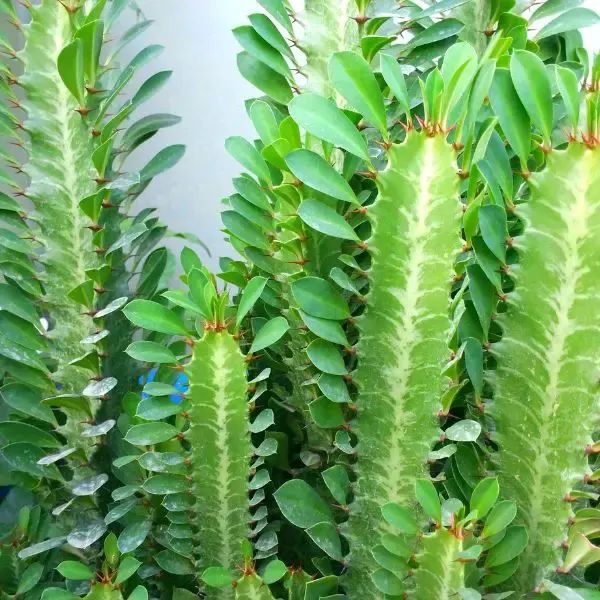
Euphorbia weaves its lovely presence in the lush tapestry of my garden, dancing happily beside my favorite Lamb’s Ear. This symbiotic relationship is nothing short of a waltz performed by nature’s best dancers.
With its stunning structure and ethereal blossoms, Euphorbia weaves a protective spell on Lamb’s Ear, sheltering it from direct sunshine and infusing the soil with nutritious secrets. Its delicate roots envelop Lamb’s Ear, providing a safe place for development and regeneration.
In exchange, Lamb’s Ear provides a calming carpet of soft, velvety leaves that embrace the base of Euphorbia. It acts as a living mulch, retaining moisture and keeping weeds at bay, allowing Euphorbia to flourish in peace.
19. Astilbe (Astilbe spp.)

Astilbe and Lamb’s Ear waltz beautifully in the wonderful dance of partnership inside the garden, each presenting their distinctive gifts to the other. Astilbe adds a delicate touch of elegance and appeal to the environment with its fluffy plumes of multicolored blossoms. These luxuriant blossoms on long branches offer a magnificent contrast against the silky silver leaves of Lamb’s Ear, forming a lovely image that captivates everyone who sees it.
However, the closeness between these two extends beyond appearances. With its preference for wet soil, Astilbe works as a moisture-retentive neighbor, keeping Lamb’s Ear hydrated during dry times. In exchange, the Lamb’s Ear’s low-growing, thick foliage functions as a living mulch, covering the soil and preserving Astilbe’s sensitive roots from harsh temperatures.
Their embrace is proof that when Astilbe and Lamb’s Ear join hands, they not only make a gorgeous display of colors and textures but also nurture and support each other in a meaningful and lovely union.
20. Hosta (Hosta spp.)
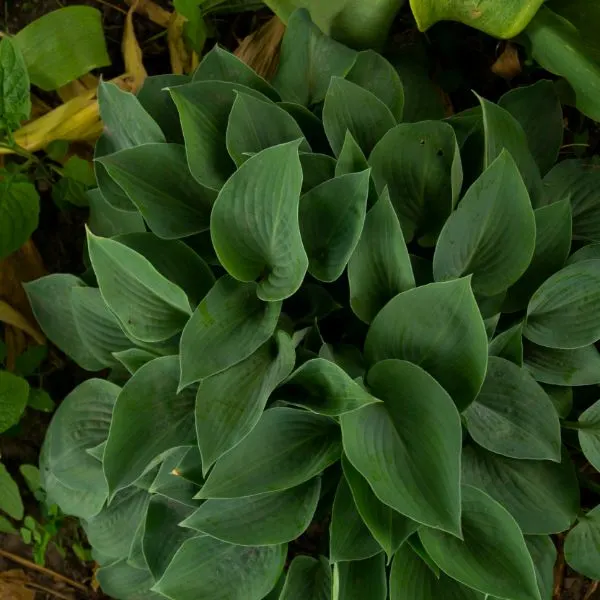
Hosta gently collaborates with Lamb’s Ear in the lovely dance of companion planting, forming a tapestry of mutual benefits. Hosta’s wide, luxuriant foliage provides a shady canopy, shielding the sensitive, velvety leaves of Lamb’s Ear from the sun’s rays. This happy relationship continues as Lamb’s Ear works as a living mulch, storing soil moisture and protecting Hosta roots from drought stress.
Furthermore, the tranquil beauty of Hosta attracts helpful insects, enticing pollinators to dance among the delicate blossoms of Lamb’s Ear, fostering plentiful pollination. In exchange, Lamb’s Ear acts as a living ground cover, inhibiting weeds that would compete for Hosta’s nutrients and stunt its development.
This powerful combination embodies the concept of partnership, creating a blooming refuge where each plant thrives, telling tales of beauty and strength to all who enter their verdant embrace.
21. Japanese Maple (Acer palmatum)
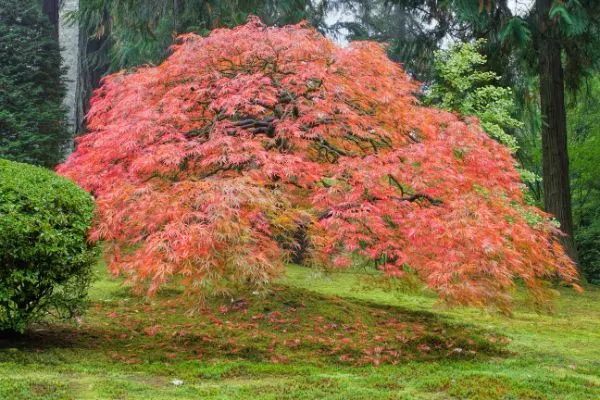
The exquisite Japanese Maple (Acer palmatum) is a charming partner to the delicate Lamb’s Ear in the harmonious world of the garden. This heavenly duo produces a symphony of beauty and tranquility. With its lacy leaf and flaming fall colors, the Japanese Maple offers dappled shade over the Lamb’s Ear, providing relief from the blazing heat. The Maple’s roots tenderly cradle the earth as the seasons dance, nourishing it for the Lamb’s Ear to thrive.
In exchange, the Lamb’s Ear serves as a devoted ground cover, shielding Maple’s roots from invading weeds and providing a living mulch to conserve moisture. Like a sponge, its velvety leaves collect morning dew and tenderly cradle the Maple’s roots. Each plant finds comfort and support in this symbiotic dance, assuring its enduring partnership through the changing tides of time.
Ornamental Grasses
22. Japanese Forest Grass (Hakonechloa macra)
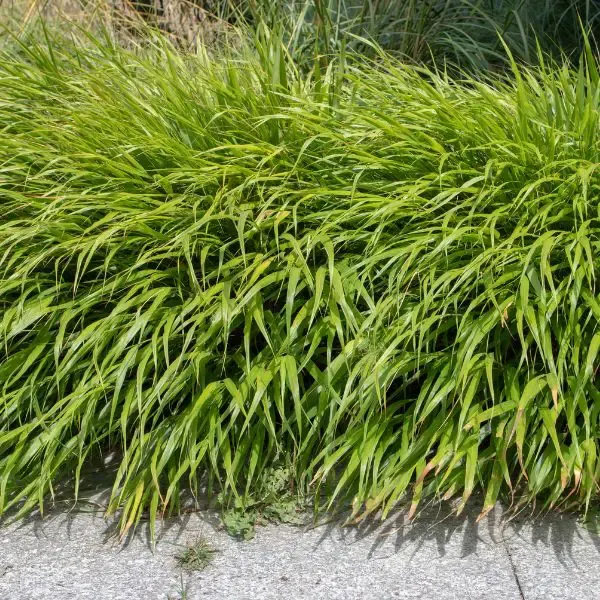
Japanese Forest Grass (Hakonechloa macra) weaves a beautiful dance with Lamb’s Ear in my garden, forming an unbreakable link of kinship.
With its flowing emerald blades and elegant temperament, this ornamental grass provides mild shade from the hot heat, enveloping its velvety foliage in a lush hug. As the sun sets, the delicate fronds of Japanese Forest Grass move in time with the air, whispering calming secrets to its surrounding Lamb’s Ear.
In exchange, Lamb’s Ear bestows its velvety presence as a living mulch, delicately cradling the soil underneath, protecting critical moisture, and preventing annoying invaders from infiltrating their tranquil refuge.
Alliums
23. Chives (Allium schoenoprasum)
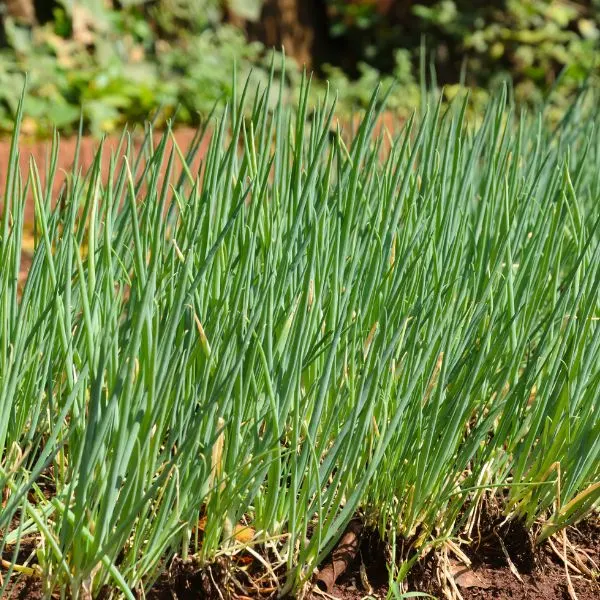
Chives and Lamb’s Ear have established a perfect relationship in the lush embrace of my garden, raising each other to new heights of vigor.
Chives nestle softly alongside the velvety Lamb’s Ear, forming a tapestry of verdant loveliness with their tiny emerald spears. These green sentinels deliver a plethora of gifts to their surrounding Lamb’s Ear because they attract adored pollinators, enticing a symphony of bees and butterflies to dance among their petals.
Chives serve as alert defenders, emitting a faint oniony perfume to dissuade pests from approaching our prized Lamb’s Ear. Furthermore, its dense growth functions as a living mulch, retaining soil moisture and protecting the land from the sun’s scorching rays. In exchange, with its wide, silvery leaves, the Lamb’s Ear provides a shade canopy for the Chives, shielding their fragile roots from the scorching sun.
Thus, Chives and Lamb’s Ear grow together within this thriving fellowship, exemplifying the essence of real partnership in the garden – where each partner contributes, nurtures, and shields, ensuring a union of plenty and grace.
Succulents:
24. Sedum (Sedum spp.)
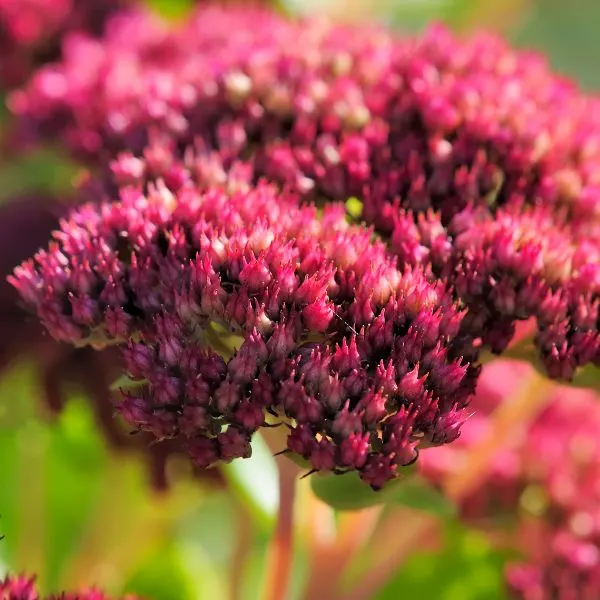
Let us explore the harmonic relationship between Lamb’s Ear and the hardy Sedum. These plants support each other in amazing ways, much like two old friends sharing a garden plot.
Lamb’s Ear works as a living mulch with its velvety leaves, providing the protective shelter that Sedum seeks throughout the hot summers. On the other hand, Sedum’s low, spreading form creates a living carpet, protecting the soil around Lamb’s Ear from invading weeds and excessive evaporation.
Furthermore, the upright growth of Lamb’s Ear provides a natural trellis for the Sedum’s tiny blossoms, enhancing their beauty for all to behold. This dynamic partnership also attracts a range of useful insects, from pollinators to pest controllers, which contributes to the overall health of their shared garden habitat.
Lamb’s Ear and Sedum, with roots interwoven under the surface, reflect the essence of real companionship, proving that when nature’s partnerships bloom, the garden flourishes in harmony.
Shrubs:
25. Russian Sage (Perovskia atriplicifolia)
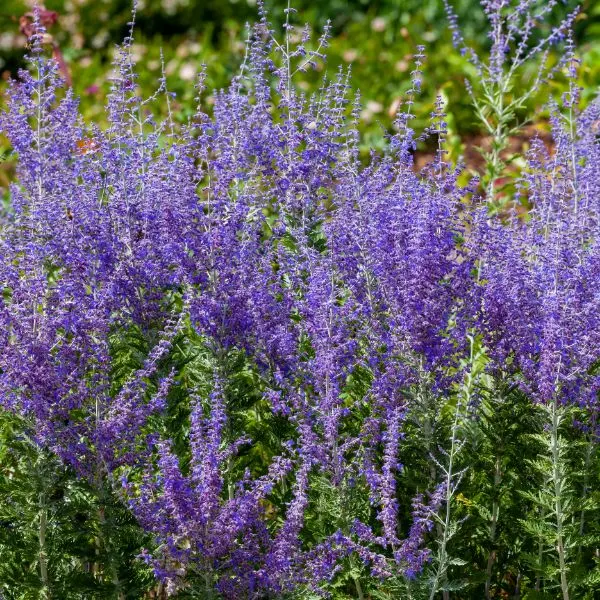
Russian Sage (Perovskia atriplicifolia) gently joins with Lamb’s Ear in my garden, creating a beautiful companion link supporting and uplifting both plants. Russian Sage adds a touch of magic with its airy silvery leaves and lavender-blue spires, providing a lovely setting for Lamb’s Ear’s velvety rosettes.
This dynamic pair flourishes together because Russian Sage’s tall, airy structure provides soft shade to Lamb’s Ear, protecting its sensitive leaves from the sun’s beams. In return, Lamb’s Ear acts as a living mulch, forming a protective blanket around the base of Russian Sage, preserving precious soil moisture, and preventing weed invasion.
But the enchantment doesn’t stop there! Their collaboration draws a variety of pollinators, with each benefiting from the presence of the other, as bees and butterflies flit from bloom to bloom, heaping plentiful blessings on both.
Russian Sage and Lamb’s Ear exemplify the art of companionship, elevating the splendor of my garden to new heights, where unity and beauty intertwine in nature’s blissful embrace.
26. Gaillardia (Gaillardia spp.)

The charming Gaillardia dances hand in hand with the ever-graceful Lamb’s Ear in the harmonic realm of companion gardening, producing a symphony of beauty and advantages. Gaillardia’s bright and flaming blossoms add a splash of color to the landscape, drawing a slew of pollinators who fly from flower to flower, showering nature’s gentle caress on Lamb’s Ear.
Gaillardia’s brilliant blossoms give a beautiful shade to Lamb’s Ear, protecting it from the sun’s blistering rays and ensuring its velvety leaves remain cool and satisfied. On the other hand, Lamb’s ear produces a living mulch beneath Gaillardia’s feet, keeping critical moisture and deterring unwanted invaders.
Their roots entwine in a symbiotic dance, producing a sanctuary for beneficial soil bacteria. Gaillardia and Lamb’s Ear are devoted partners, encouraging each other’s development and providing the garden with an everlasting feeling of joy and vigor.
27. Baptisia (Baptisia spp.)
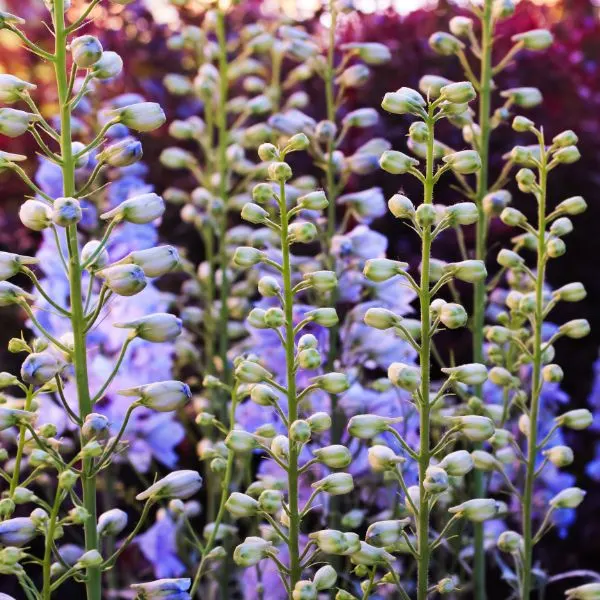
Baptisia and Lamb’s Ear form a peaceful alliance that supports their development and beauty in the beautiful dance of companion planting. With its deep roots, Baptisia serves as a tenacious defender for Lamb’s Ear, sheltering it from severe winds and creating a secure foundation. In return, the velvety leaves of Lamb’s Ear protect the soil around Baptisia from weed invasion and excessive evaporation.
Furthermore, Baptisia’s towering and statuesque presence provides welcome shade for the low-growing Lamb’s Ear, shielding it from searing sun rays during the hot summer days. The moisture-retentive characteristics of Lamb’s Ear generously conserve the soil’s moisture for Baptisia, producing an oasis of hydration during dry times.
Their combined characteristics weave an exquisite tapestry of beauty and durability, a monument to nature’s peaceful cooperation in the fertile domain of companion planting.
28. Phlox (Phlox spp.)
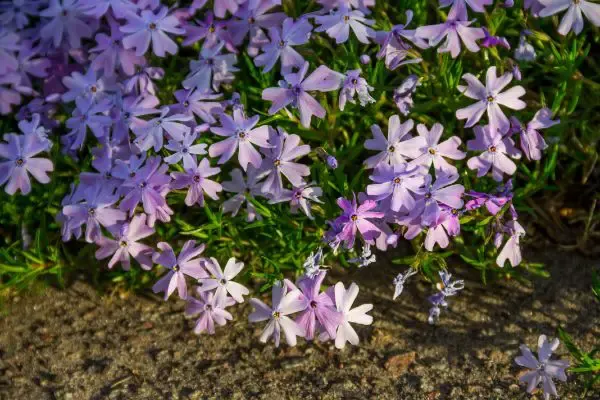
A perfect collaboration emerges in the beautiful garden dance between Lamb’s Ear and Phlox, praising nature’s brilliance. The velvety leaves of Lamb’s Ear provide a soft, protecting carpet, shielding the roots of Phlox from the searing sun and nurturing a cool, damp environment. In exchange, the vivid Phlox flowers break forth in a symphony of colors, drawing a swarm of bees that pollinate both partners, promoting their growth and vitality.
Phlox’s desire for vertical elegance allows it to climb gracefully over the ground-hugging Lamb’s Ear, providing vertical flair to the landscape. Phlox obtains a solid ground cover in this lovely duet, while Lamb’s Ear gains a brilliant, flying partner. They create a tapestry of beauty together, one nourishing the other in a waltz of symbiotic happiness.
Bad Companion Plants For Lamb Ear
1. Mint

Planting Mint (Mentha spp.) next to Lamb’s Ear might have unintended results. Mint’s rapid growth and invasive nature may swiftly engulf the fragile Lamb’s Ear, depriving it of vital sunshine and nutrition. Furthermore, Mint’s roots produce allelopathic substances that may impede Lamb’s Ear’s development and overall health, making it difficult for both plants to coexist.
2. Peppermint
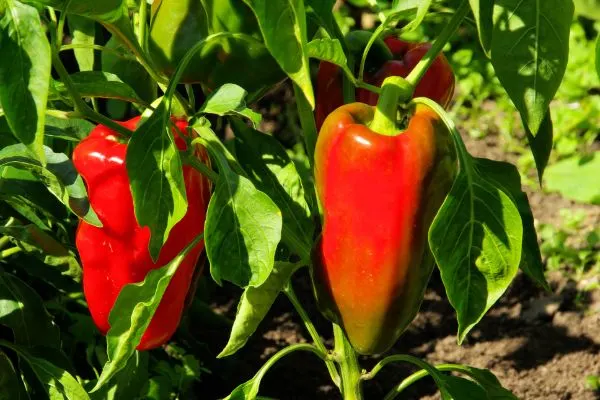
Planting Peppermint beside Lamb’s Ear can be detrimental to their harmonious cohabitation. Peppermint’s aggressive character may dominate the soft Lamb’s Ear, limiting its development and dissemination. Furthermore, the invasive nature of peppermint can result in competition for essential resources such as space and nutrients, compromising the peaceful balance that both plants seek. Caution is suggested to preserve the peaceful relationship between Lamb’s Ear and its surrounding vegetation.
3. Lemon balm
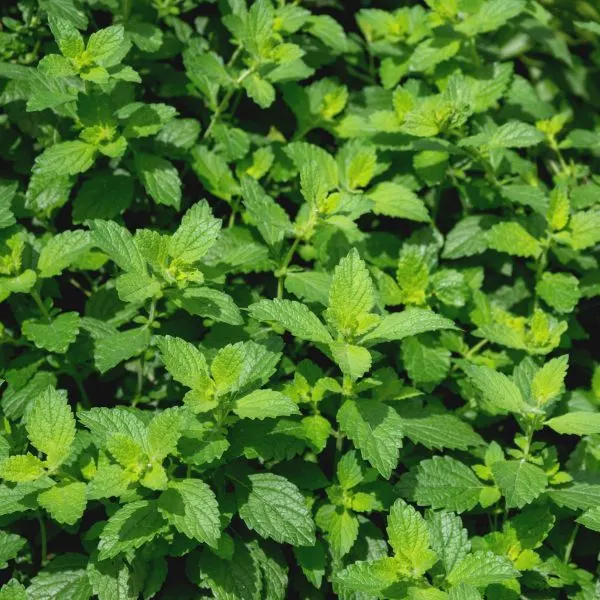
Planting Lemon Balm (Melissa officinalis) beside Lamb’s Ear might result in a collision of growth patterns and resource competition. The robust strength of lemon balm may dominate the soft Lamb’s Ear, inhibiting its development. Furthermore, the quick expansion of Lemon Balm may intrude on the area required by Lamb’s Ear, decreasing its capacity to thrive. This unlucky coupling can lead to a power struggle, undermining the potential benefits of a harmonic companion planting arrangement.
4. Lamb’s Quarter
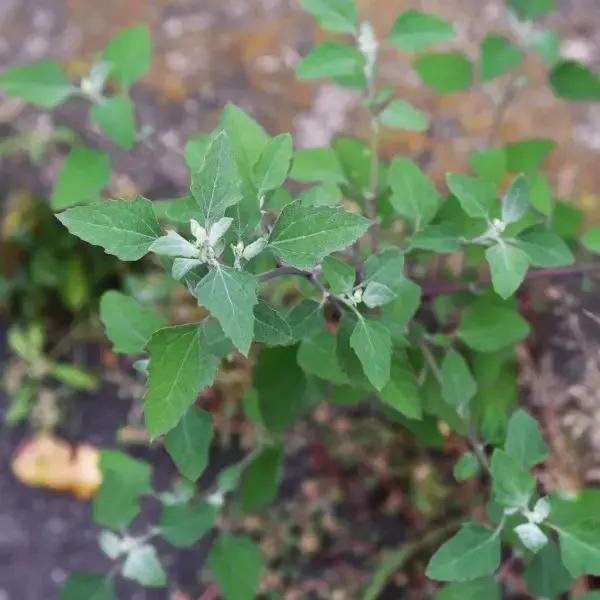
Planting Lamb’s Quarter (Chenopodium album) next to Lamb’s Ear might have negative implications. The quick growth and invasive nature of Lamb’s Quarter can outcompete and overwhelm the delicate Lamb’s Ear, leading it to compete for important resources like sunshine, water, and nutrients. Furthermore, Lamb’s Quarter may attract pests that injure both plants, upsetting the serene harmony they formerly enjoyed and making it an inappropriate companion for the beautiful Lamb’s Ear.
5. Black Walnut
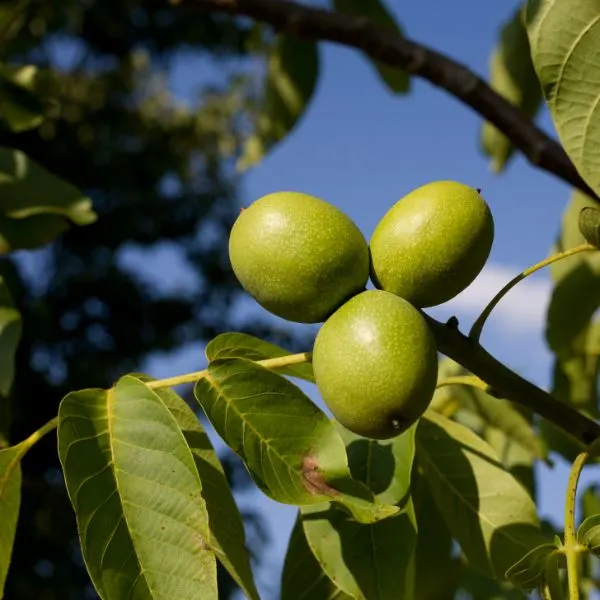
Planting Black Walnut (Juglans nigra) close to Lamb’s Ear might cause problems. The roots of the Black Walnut emit juglone, a poisonous chemical that inhibits the development of many plants, including Lamb’s Ear. The chemical interference reduces the capacity of Lamb’s Ear to flourish, resulting in stunted growth and fading leaves. The robustness of the Lamb’s Ear is no match for the suppressive tendency of the Black Walnut in this unlucky coupling, resulting in an unharmonious and challenging partnership.
FAQs
What is the best fertilizer for a lamb’s ear?
Grow lamb’s ears on well-drained, compost-enriched soil without the need for additional fertilizer. These plants thrive in soil that is evenly moist but not waterlogged.
Avoid using overhead sprinklers for watering, as it can lead to issues like rot. Instead, prune the plants during the summer to prevent overcrowding and maintain their health. Lamb’s ears dislike heavy soil, so ensuring proper drainage for optimal growth is essential.
Can you propagate lamb’s ear from cuttings?
You can grow Lamb’s ears either from seeds or by splitting existing plants. While it is possible to propagate them from cuttings, the success rate is generally low. As such, it is often more straightforward to divide established plants instead. This method ensures a higher success rate in creating new Lamb’s ear plants.
Where is the best place to plant lambs ear?
Lamb’s ear thrives in ordinary, well-drained soils that are dry to medium in moisture levels and receive full sun to partial shade. Overwatering should be avoided, as it can lead to disease and other issues.
It’s essential to prevent damp leaves and excessive humidity, especially during the summer months, as these conditions can negatively impact the plant’s health. Providing midday shade, particularly in the hot summer months, is preferred by the Lamb’s ear to ensure it remains healthy and robust.
What is the herb lamb’s ear used for?
In addition to being used to soak up blood and as a dressing, lamb’s ear has a history of being utilized as a poultice and is known for its analgesic properties. It was commonly used on its own or combined with other plants like comfrey.
One of its common applications is to alleviate swelling resulting from bee or wasp stings. The plant’s medicinal qualities have made it a valuable natural remedy for various topical applications throughout history.
Wrapping up
Lamb’s ear offers numerous advantages, making it a low-maintenance gem once it has settled into its surroundings. Once established, it requires little attention and seldom needs fertilizer. This adaptable plant provides various benefits, such as air purification, soothing effects that can lower hypertension, promoting skin radiance, and attracting helpful pollinators.
Beyond its non-toxic nature, Lamb’s Ear possesses exceptional medicinal properties. Its leaves can be used topically to relieve mild arthritis, itching and aid in wound healing. Additionally, when planted alongside suitable companion plants, its delicate, silvery leaves add an appealing touch to the environment, offering architectural interest throughout the year.
It is best to plant Lamb’s Ear as container-grown nursery plants in the spring or early fall for optimal growth. While the growth rate may vary among species, it generally tends to be slow. Though a one-gallon plant may bloom in its first year, it might take several years to reach full size. While Lamb’s Ear is generally easy to cultivate with proper care, it can be sensitive to unfavorable environmental conditions.
Constructing artificial berms with porous soil in areas with heavy soil is generally recommended to create excellent planting conditions. This will provide Lamb’s Ear with the proper shelter it needs to thrive and bloom beautifully.
More companion plants
